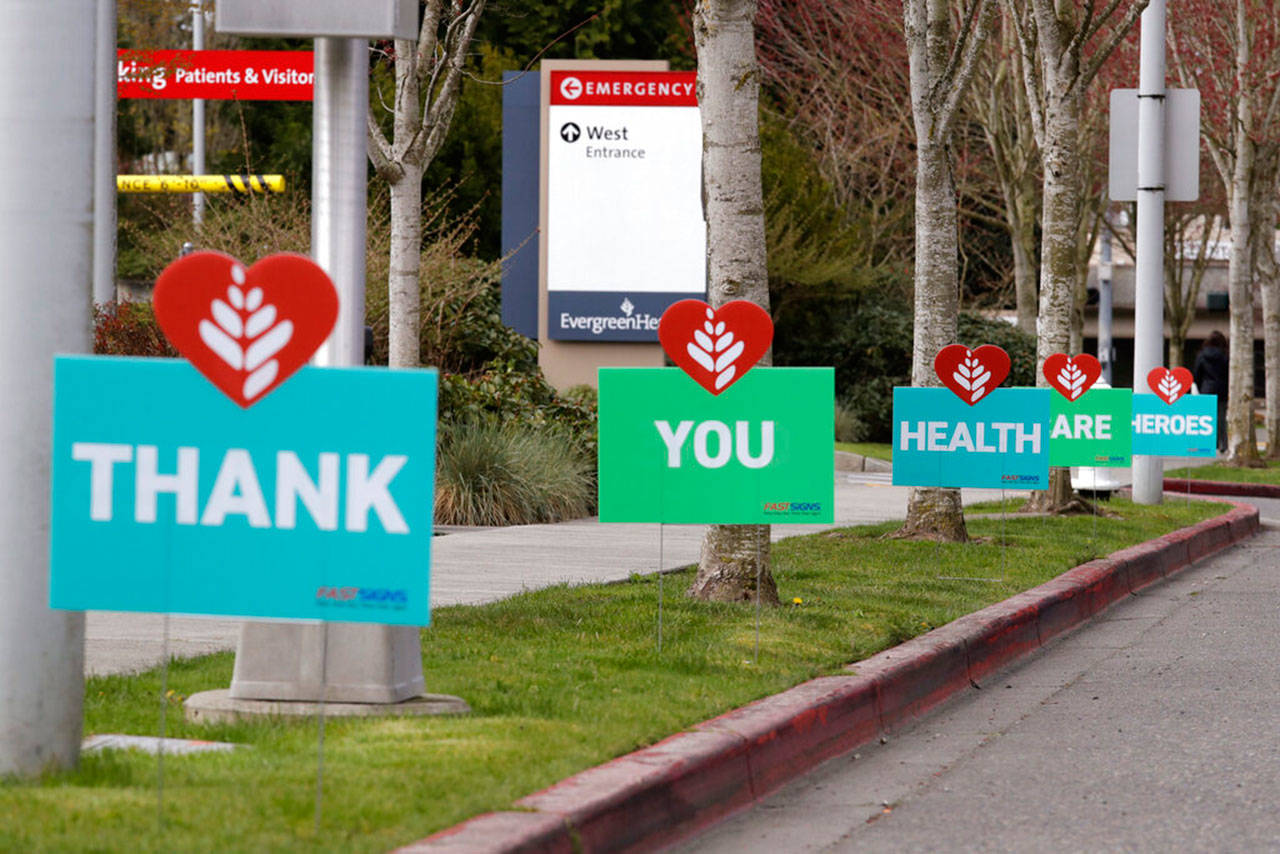By The Herald Editorial Board
This is what things have come to as Washington state and other states face peak demand in the coming weeks for medical care in hospitals, nursing homes and other medical facilities as the COVID-19 pandemic continues its sweep over us:
Nurses, after putting in a full day at work, go home to cobble together their own face shields and other personal protective equipment. Others are wearing swim goggles. Family and friends have pulled sewing machines out of closets to begin churning out face masks for workers to wear over N95 respirators so they can be reused. Some hospital workers are wearing rain ponchos and plastic garbage bags as surgical gowns.
That’s American ingenuity and determination confronting the sinking feeling that follows after being told by one’s federal government: You are on your own.
After weeks of cagey responses from the Trump administration about the availability of medical supplies — including the ventilators that the sickest COVID patients need to keep breathing — came the news Wednesday that the federal government’s emergency stockpile of respirator masks, gloves and other medical supplies is nearly exhausted, The Washington Post reported.
New York state, where the need is currently most pressing, faces a shortage of 11,000 ICU beds, equipped with ventilators, according to data from the University of Washington’s Institute of Health Metrics and Evaluation. Nationwide, nearly 32,000 ventilators will be needed at the pandemic’s peak, the IHME estimates. As of March 28, the Federal Emergency Management Agency had delivered 8,100 ventilators nationwide. It may have about 5,000 remaining.
The realization that states are on their own appears understood by those states’ leaders. Also on Wednesday, Gov. Jay Inslee, with logistical assistance offered by the Association of Washington Businesses, asked companies in the state to shift production to the medical equipment needed by health care workers and first responders. Among them, Outdoor Research, which has long made such equipment for the military, committed to making PPE gloves to supply the response, and could be making as many as 200,000 gloves a day by the end of April, its chief executive said Wednesday at a news conference with the governor.
Numerous distilleries and winemakers in Snohomish County and the state have given over production to make hand sanitizer for first responders and others.
And, a Bothell firm that makes ventilators, Ventech, is working with General Motors, using the auto giant’s supply chain and capacity to produce parts so production of the ventilators can be ramped up to as many as 10,000 a month.
Yes, that work has been facilitated by President Trump’s enactment of the Defense Production Act, but its authorization was delayed and started only haltingly over last weekend.
[[Support our Snohomish County journalism. Subscribe to The Herald.]]
The looming shortages — within the medical supply system and in FEMA’s stockpile — should have been clear to many earlier, especially to the federal agencies, which should have been able to assess their inventories and recognize the severity of demand that was about to hit.
Two weeks ago the president informed governors in a conference call that they — and not the federal government — would be responsible for obtaining their own medical supplies. Many were attempting to do that, Massachusetts Gov. Charlie Baker, a Republican, told President Trump, but on three occasions that state was outbid for supplies. The winning bidder? The federal government, said Baker, the Bloomberg news service reported.
Why was the Defense Production Act not earlier in force to address these shortages? And why is the act — which gives the federal government the power to require companies to fulfill government orders before those of other clients — not now getting wider use to produce the supplies needed not only to protect the safety of health care workers but also that of police, firefighters, emergency aid crews and even grocery workers.
“It would be a whole lot easier if the president himself told business to step up,” Sen. Patty Murray, D-Washington, said in an interview with The Herald on Wednesday. “We are pretty much being told we are on our own. None of us ever imagined a national public health crisis where you’re told you’re on your own.”
Yet, we likely will need to rely on ourselves for some time.
Washington state, according to the IHME, can expect that its peak medical resource demand will arrive April 11, before demand then begins to recede. Nationwide, that peak is estimated to arrive four days later. But we should not let up on production, voluntary and mandatory, any time soon.
Past experience with pandemics warns that — even after new infections and deaths level off later this summer — we should prepare for a return of the coronavirus that causes COVID-19 by the fall or winter. While there is the promise of anti-viral and other treatments for COVID-19 and work is progressing on a vaccine, that solution still is likely to be a year to 18 months away.
There are immense advantages to national centralized stockpiles of emergency equipment and supplies, the kind of work FEMA and the Department of Homeland Security were chartered to undertake; first because it is supposed to ensure quick dispatch of that equipment, and secondly, because it heads off the kind of bidding wars among states — and the hoarders, price-gougers and black market — that drive up costs and create shortages.
Regardless — as nearly empty federal warehouses now attest — we are on our own.
Talk to us
> Give us your news tips.
> Send us a letter to the editor.
> More Herald contact information.

























